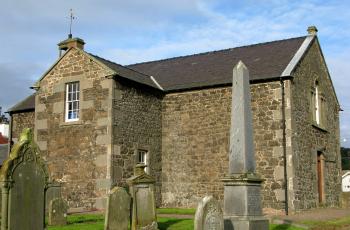- Navigation:
- Back to the Corpus index page
- RSS
St Madoes / Cairnie Parish Church
St Madoes Church, exterior, from south east
- Dedication: St Modocus
- Diocese of Dunblane
- County of Perthshire
- Perth and Kinross Council
- NO 1966 2119
Summary description
Nothing survives of the medieval parish church of St Madoes, the site of which is assumed to be occupied by the church that was built to serve the parish in 1798-9.
Historical outline
Dedication: St Modocus
The origins and early history of this parish are unrecorded, but the control of the patronage and advowson by the Leslie earls of Rothes, who were heirs of part of the lordship of Abernethy in the fourteenth century, raises the probability that it was originally a component of the properties of the abbots of Abernethy.(1) A parson of St Madoes witnessed a charter of Sir John of Inchyra between 1274 and 1291.(2) The church is probably to be identified with the free parsonage of ‘Santo Maghot’ in Bagimond’s Roll, which the editor identified as the church of Kilmahug.(3) The placing of ‘Santo Maghot’ in the list of names of churches in the east of the diocese, however, suggests strongly that it is St Madoes. The advowson of the church was confirmed to the Leslies in 1513 and the parsonage and vicarage of St Madoes were still independent at the Reformation.(4)
Notes
4. RSS, i, no 2501; Donaldson (ed.), Thirds of Benefices, 15; Kirk (ed.), Book of Assumptions, 345.
Architectural description
An extended history of Christian worship at St Madoes is indicated by the fact that the churchyard has been the find spot for two Early Christian cross slabs, the finest of which is now displayed in Perth Museum.
Nothing is known of the precise location and architectural form of the medieval parish church. According to the entry in the Statistical Account of 1792, the church that then existed bore an inscription with the date 1610, though we do not know if that referred to a complete rebuilding or the augmentation of an existing building. Further works were carried out in 1676. The existing building, however, is a T-shaped structure erected in 1798-9, and the author of the section in the New Statistical Account of 1845 stated specifically that ‘the old church was taken down’ when the new one was built. Nevertheless, it is thought to be on the same site as its predecessor, though its alignment from north-east to south-west suggests it is unlikely to occupy the exact footprint of the medieval church.
Bibliography
Allen, J.R. and Anderson, J., 1903, The Early Christian Monuments of Scotland, Edinburgh, pt 3, 292-6, 328-9.
Cowan, I.B., 1967, The parishes of medieval Scotland, (Scottish Record Society), Edinburgh, 178.
Donaldson, G. 1949, Accounts of the collectors of thirds of benefices, (Scottish History Society), Edinburgh, 15.
Dunlop, A.I., 1939, ‘Bagimond’s Roll, statement of the tenths of the kingdom of Scotland’ Miscellany of the Scottish History Society, vi, 1-77, at 54 71.
Gifford, J., 2007, The Buildings of Scotland, Perth and Kinross, New Haven and London, 686.
Hay, G., 1957, The architecture of Scottish post-Reformation churches, Oxford, 169, 270.
Kirk, J., 1995, The books of assumption of the thirds of benefices, (British Academy) Oxford, 345.
Melville, L, 1939, The fair land of Gowrie, Coupar Angus, 53-4.
New Statistical Account of Scotland, 1845, Edinburgh and London, x, 683.
Registrum Secreti Sigilli Regum Scotorum, 1908-82, ed. J.M. Thomson et al., Edinburgh, i, no 2501.
Royal Commission on the Ancient and Historical Monuments of Scotland, Canmore database.
Royal Commission on the Ancient and Historical Monuments of Scotland, 1994, South-East Perth, an archaeological landscape, Edinburgh, 163.
Statistical Account of Scotland, 1791-9, ed. J. Sinclair, Edinburgh, iii (1792), 633.
Map
Images
Click on any thumbnail to open the image gallery and slideshow.









